Students can Download Science Term 3 Chapter 1 Sound Questions and Answers, Notes Pdf, Samacheer Kalvi 8th Science Book Solutions Guide Pdf helps you to revise the complete Tamilnadu State Board New Syllabus and score more marks in your examinations.
Tamilnadu Samacheer Kalvi 8th Science Solutions Term 3 Chapter 1 Sound
Samacheer Kalvi 8th Science Sound Text Book Exercises
I. Choose the best answer:
Samacheer Kalvi Guru 8th Science Question 1.
Sound waves travel very fast in …………..
(a) air
(b) metals
(c) vacuum
(d) liquids
Answer:
(b) metals
Samacheer Kalvi 8th Science Book Solutions Question 2.
Which of the following are the characteristics of vibrations?
(i) Frequency
(ii) Time period
(iii) Pitch
(iv) Loudness
(a) (i) and (ii)
(b) (ii) and (iii)
(c) (iii) and (iv)
(d) (i) and (iv)
Answer:
(c) (iii) and (iv)
Samacheer Kalvi Guru 8th Question 3.
The amplitude of the sound wave decides it’s ……………
(a) speed
(b) pitch
(c) loudness
(d) frequency
Answer:
(c) loudness
Samacheer Kalvi 8th Science Guide Question 4.
What kind of musical instrument is a sitar?
(a) String instrument
(b) Percussion instrument
(c) Wind instrument
(d) None of these
Answer:
(a) String instrument
8th Standard Sound Lesson Question 5.
Find the odd one out.
(a) Harmonium
(b) Flute
(c) Nadaswaram
(d) Violin
Answer:
(d) Violin
Reason:
Violin is a stringed instrument. Other are wind or reed instruments.
Samacheer Kalvi.Guru 8th Question 6.
Noise is produced by …………..
(a) vibrations with high frequency
(b) regular vibrations.
(c) regular and periodic vibrations
(d) irregular and non-periodic vibrations.
Answer:
(d) irregular non-periodic vibrations
Samacheer Kalvi 8th Science Question 7.
The range of audible frequency for the human ear is …………..
(a) 2 Hz to 2000 Hz
(b) 20 Hz to 2000 Hz
(c) 20 Hz to 20000 Hz
(d) 200 Hz to 20000 Hz
Answer:
(c) 20 Hz to 20000 Hz
Samacheer Kalvi.Guru 8th Science Question 8.
If the amplitude and frequency of a sound wave are increased, which of the following is true?
(a) Loudness increases and pitch is higher
(b) Loudness increases and pitch is unchanged
(c) Loudness increases and pitch is lower
(d) Loudness decreases and pitch is lower
Answer:
(a) Loudness increases and pitch is higher
II. Fill in the blanks:
- Sound is produced by …………
- The vibrations of a simple pendulum are also known as …………
- Sound travels in the form of …………
- High frequency sounds that cannot be heard by you are called …………
- Pitch of a sound depends on the ………… vibration.
- If the thickness of a vibrating string is increased, its pitch …………
Answer:
- vibrating bodies
- oscillation
- mechanical waves
- Ultrasonic
- frequency of the
- decrease
III. Match the following:
- Ultrasonics – Frequency below 20Hz
- Speed of sound in air – Needs material medium
- Infrasonics – 330 m
- Sound propagation – Frequency more than 20000 Hz
Answer:
- Ultrasonics – Frequency more than 20000 Hz
- Speed of sound in air – 330 m
- Infrasonics – Frequency below 20Hz
- Sound propagation – Needs material medium
IV. Choose the correct option:
(a) Both assertion and reason are true and reason is the correct explanation of assertion.
(b) Both assertion and reason are true but reason is not the correct explanation of assertion.
(c) Assertion is true but reason is false.
(d) Assertion is false but reason is true.
(e) Both Assertion and reason are false.
Samacheer Kalvi Guru 8 Science Question 1.
Assertion: When lightning strikes, the sound is heard a little after the flash is seen.
Reason: The velocity of light is greater than that of the sound.
Answer:
(a) Both assertion and reason are true and reason is the correct explanation of assertion.
Samacheer Kalvi .Guru 8th Question 2.
Assertion: Two persons on the surface of moon cannot talk to each other.
Reason: There is no atmosphere on moon.
Answer:
(a) Both assertion and reason are true and reason is the correct explanation of assertion.
V. Answer briefly:
Samacheer Kalvi Guru 8th Science Solutions Question 1.
What are vibrations?
Answer:
Vibration means a kind of rapid to and fro motion of an object.
Samacheer Kalvi 8th Standard Science Question 2.
Give an example to show that light travels faster than sound.
Answer:
Lightning:
The most common example of showing that light travels faster than sound is lightning. Whenever a lightning strikes, you see the lightning first and then hear the thunder after some time.
8th Science Solutions Samacheer Kalvi Question 3.
To increase loudness of sound by four times, by how much should the amplitude of vibration be changed?
Answer:
Loudness of a sound depends on the amplitude of the vibration. So to increase loudness of sound by four times, the amplitude of the vibration also to be increased by four times.
Samacheer Kalvi 8th Science Solutions Question 4.
What is an ultrasonic sound?
Answer:
A sound with a frequency greater than 20000 Hz is called as ultrasonic sound.
Science Term 3 Question 5.
Give two differences between music and noise.
Answer:
Music:
- The sound that provides a pleasing sensation to the ear.
- It is produced by the regular patterns of vibrations.
Noise:
- Sound that is unpleasant to the ear
- It is produced by the irregular and non-periodic vibrations.
8th Science Sound Lesson Question 6.
What are the hazards of noise pollution?
Answer:
- Noise may cause irritation, stress, nervousness and headache.
- Long term exposure to noise may change the sleeping pattern of a person.
- Sustained exposure to noise may affect hearing ability. Sometimes, it leads to loss of hearing.
- Sudden exposure to louder noise may cause a heart attack and unconsciousness.
- Noise of horns, loud speakers, etc., cause disturbances leading to lack of concentration.
- Noise pollution affects a person’s peace of mind.
8th Standard Science Sound Lesson Question 7.
Mention few measures to be taken to reduce the effect of noise pollution.
Answer:
- Strict guidelines should be set for the use of loudspeakers on social, religious and political occasions.
- All automobiles should have effective silencers.
Samacheer Kalvi 8th Question 8.
Answer:
Define the following terms:
- Amplitude
- Loudness
1. Amplitude:
Amplitude is the maximum displacement of a vibrating particle from its mean position. It is denoted by ‘A’ and its unit is ‘metre’ (m).
2. Loudness:
It is defined as the characteristic of a sound that enables us to distinguish a weak or feeble sound from a loud sound. The unit of loudness of sound is decibel (dB).
Samacheer Kalvi Guru 8th Standard Question 9.
How does planting trees help in reducing noise pollution?
Answer:
- Plant parts such as stems, leaves, branches wood, etc., absorb sound.
- Rough bark and thick, fleshy leaves are particularly effective at absorbing sound due to their dynamic surface area and helps in reducing noise pollution.
VI. Answer in detail:
Question 1.
Describe an experiment to show that sound cannot travel through vacuum.
Answer:
1. Aim:
To prove that sound cannot travel through vacuum and it needs a medium for propagation.
2. Materials Required:
Bell jar, mobile phone and vacuum pump.
Procedure:
- Take a bell jar and a mobile phone.
- Switch on the music in the mobile phone and place it in the jar.
- Now, pump out the air from the bell jar using a vacuum pump.
- As more and more air is removed from the jar, the sound from the mobile phone becomes feebler and finally, very faint.

Conclusion:
This experiment proves that sound cannot travel in vacuum and it needs a medium.
Question 2.
What are the properties of sound?
Answer:
- Loudness
- Pitch
- Quality or Timbre
1. Loudness:
- It is defined as the characteristic of a sound that enables us to distinguish a weak or feeble sound from a loud sound.
- The loudness of a sound depends on its amplitude.
- Higher the amplitude louder will be the sound and vice-versa.
- When a drum is softly beaten, a weak sound is produced. However, when it is beaten strongly, a loud sound is produced.
- The unit of loudness of sound is decibel (dB).
2. Pitch:
- The pitch is the characteristic of sound that enables us to distinguish between a flat sound and a shrill sound.
- Higher the frequency of sound, higher will be the pitch. High pitch adds shrillness to a sound.
- The sound produced by a whistle, a bell, a flute and a violin are high pitch sounds.
3. Quality or Timbre:
- The quality or timbre is the characteristic of sound that enables us to distinguish between two sounds that have the same pitch and amplitude.
- For example in an orchestra, the sounds produced by some musical instruments may have the same pitch and loudness.
Question 3.
What steps should be taken to reduce the effect of noise pollution?
Answer:
- Strict guidelines should be set for the use of loudspeakers on social, religious and political occasions.
- All automobiles should have effective silencers.
- People should be encouraged to refrain from excessive honking while driving.
- Industrial machines and home appliances should be properly maintained.
- All communication systems must be operated in low volumes.
- Residential areas should be free from heavy vehicles.
- Green corridor belt should be set up around the industries as per the regulations of the pollution control board.
- People working in noisy factories should wear ear plugs.
- People should be encouraged to plant trees and to use absorbing materials like curtains and cushions in their home.
Question 4.
Describe the structure and function of the human ear.
Answer:
- The outer and visible part of the human ear is called pinata (curved in shape).
- It is specially designed to gather sound from the environment, which then reaches the ear drum (tympanic membrane) through the ear canal.
- When the sound wave strikes the drum, the vesicles move inward and outward to create the vibrations.
- These vibrations are then picked up by special types of cells in the inner ear. From the inner ear the vibrations are sent to the brain in the form of signals.
- The brain perceives these signals as sounds.
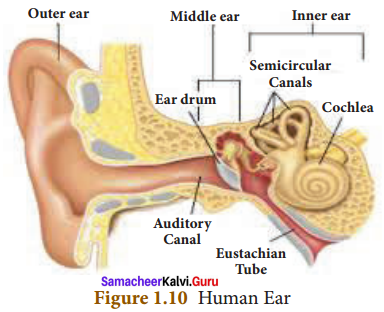
VII. Problem:
Question 1.
Ruthvik and Ruha hear a gunshot 2 second after it is fired. How far away from the gun they are standing ? (Speed of sound in air is equal
to 330ms-1).
Solution:
Given data: time t = 2s
Speed of sound V = 330 ms-1
To find: Distance d = ?
Formula: Distance = Speed x time
Distance d = 330 x 2 = 660 m
Question 2.
A sound wave travels 2000 m in 8 s. What is the velocity of the sound?
Solution:
Given data:
Distance travelled by a sound wave d = 2000 m
time taken t = 8s
To find: Velocity of sound V = ?
Formula:
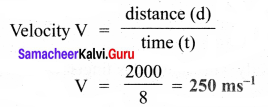
Question 3.
What is the frequency of a mechanical wave that has a velocity of 25 ms-1 and a wavelength of 12.5 m?
Solution:
Given data: Frequency n = ?
Velocity V = 25 ms-1
To find: Frequency n = ?

Question 4.
What is the wavelength?
Solution:
Given data:
Frequency n = 500 Hz
Speed V = 200 ms-1
To find: Wavelength λ = ?

Samacheer Kalvi 8th Science Sound Additional Questions
I. Choose the correct Answer:
Question 1.
Sound cannot travel through ………………..
(a) solid
(b) liquid
(c) vacuum
(d) air
Answer:
(c) vacuum
Question 2.
Vibrations in a body produce ………………..
(a) pressure
(b) sound
(c) density
(d) current
Answer:
(b) sound
Question 3.
Frequency is expressed in ………………..
(a) hertz
(b) meter
(c) Kilogram
(d) second
Answer:
(a) hertz
Question 4.
Unwanted sounds are called ………………..
(a) noise
(b) music
(c) both a and b
(d) none
Answer:
(a) noise
Question 5.
Pitch of sound is determined by its ………………..
(a) speed
(b) loudness
(c) amplitude
(d) frequency
Answer:
(d) frequency
Question 6.
The hearing range of human ear is ………………..
(a) 20 Hz to 20 kHz
(b) less than 20 Hz
(c) more than 20 k Hz
(d) none
Answer:
(a) 20 Hz to 20 kHz
Question 7.
The voices of men, women and children differ because of difference in their ………………..
(a) lungs
(b) vocal cords
(c) larynx
(d) wind pipe
Answer:
(b) vocal cords
Question 8.
The time taken for one complete vibration is called its ………………..
(a) loudness
(b) pitch
(C) time period
(d) frequency
Answer:
(c) time period
Question 9.
……………….. instruments produce a specific sound when they are struck, scrapped or clashed together.
(a) Reed
(b) Stringed
(c) Percussion
(d) None
Answer:
(c) Percussion
Question 10.
Bats produce ……………….. sound during screaming.
(a) infrasonic
(b) ultrasonic
(c) noise
(d) none
Answer:
(b) ultrasonic
II. Fill in the blanks:
- …………… is produced when an object is set to vibrate.
- The substance through which sound is transmitted is called ……………
- Sound cannot travel in ……………
- The speed of sound is …………… in solids than in liquids.
- …………… is the distance between two consecutive particles, which are in the same phase of vibration.
- …………… is the number of vibrations of a particle in the medium in one second.
- In any medium, as the …………… increases, the speed of sound also increases.
- The speed of sound in air is 331 ms-1 at …………… and …………… at 22°C.
- The unit of frequency is ……………
- The amount of water vapour in the air is known as ……………
Answer:
- Sound
- medium
- vacuum
- more
- Wavelength
- Frequency
- temperature
- 0°C, 344 ms-1
- hertz
- humidity
III. True or False – if false, give the correct statement:
Question 1.
The seismic wave formed during earthquake is an example for a transverse wave.
Answer:
False:
Correct statement: The seismic wave formed during earthquake is an example for a longitudinal wave.
Question 2.
The loudness of a sound depends on its pitch.
Answer:
False:
Correct statement: The loudness of a sound depends on its amplitude.
Question 3.
The pitch is the characteristic of sound that enables us to distinguish between a flat sound and a shrill sound.
Answer:
True:
Question 4.
The voice of a female has a lower pitch than a male.
Answer:
False:
Correct statement: The voice of a female has a higher pitch than a male.
Question 5.
Longitudinal waves are produced in solids liquids and also in gases.
Answer:
True
IV. Match the following:
Question 1.
- String vibration – (a) Flute
- Membrane vibration – (b) Bicycle bell
- Vibration of air – (e) Table
- Vibration of plate – (d) Gitar
Answer:
- d
- c
- a
- b
Question 2.
- Audible range – (a) 50 Hz to 45000 Hz
- Infrasonic range – (b) Above 20.000 Hz
- Ultrasonic range – (c) 20 Hz to 20 k Hz
- Dog’s hearing range – (d) Below 20 Hz
Answer:
- c
- d
- b
- a
Question 3.
- pitch – (a) Woman
- Loudness – (b) Man
- Shriller voice – (c) Frequency
- Flatter voice – (d) Amplitude
Answer:
- c
- d
- a
- b
V. Assertion and Reason:
Mark the correct choice as:
(a) Both assertion and reason are true and reason is the correct explanation of assertion.
(b) Both assertion and reason are true but reason is not the correct explanation of assertion.
(c) Assertion is true but reason is false.
(d) Assertion is false but reason is true.
(e) Both Assertion and reason are false.
Question 1.
Assertion: Sound waves do not travel through vacuum.
Reason: The speed of sound Is too small when compared to speed of light.
Answer:
(b) Both assertion and reason are true but reason is not the correct explanation of assertlon.
Reason:
Sound is mechanical wave, which require medium to travel.
Question 2.
AssertIon: We cannot hear the sound produced by a vibrating pendulum.
Reason: The frequency of the pendulum is very less.
Answer:
(a) Both assertion and reason are true and reason Is the correct explanation of assertion.
Question 3.
Assertion: Trees should be planted along the road to control noise pollution.
Reason: Trees act as noise buffers.
Answer:
(a) Both assertion and reason are true and reason ¡s the correct explanation of assertion.
Question 4.
Assertion: Women have shriller sound than men.
Reason: Men produced higher frequency sound than women.
Answer:
(c) Assertion is true but reason is false
Reason:
Women produce higher frequency sound than men.
VI. Pick out the odd one and give reason:
Question 1.
Trumpet, Flute, Saxophone, Mouthorgan.
Answer:
Mouthorgan.
Reason:
Mouthorgan is a reed instrument whereas the others are wind instruments.
Question 2.
Drum, Violin, Guitar, Sitar.
Answer:
Drum.
Reason:
Drum is a percussion instrument whereas the others are stringed instruments.
Question 3.
Sonar, Gatton’s whistle, Sonogram, hydrophone.
Answer:
Hydrophone.
Reason:
Hydrophone uses infrasonic wave whereas the others are using ultrasonic sound wave.
VII. Very short answer questions:
Question 1.
In which medium the speed of the sound is maximum?
Answer:
Solids.
Question 2.
On which factor pitch of the sound depends?
Answer:
Frequency.
Question 3.
What types of medium is required for sound to travel?
Answer:
Solid, liquid and gases.
Question 4.
Can sound travel through vacuum?
Answer:
No, sound cannot travel through vacuum. It needs medium to travel.
Question 5.
Do the frequency of sound produced by Men and Women are same?
Answer:
No, the frequency of sound produced by men and women are different.
Question 6.
Name the sound producing organ in human.
Answer:
Voice box or Larynx.
Question 7.
What is the name of the sound produced by irregular vibrations?
Answer:
Noise.
Question 8.
Mention the name of passage is the outer ear which carries sound waves to the eardrum.
Answer:
Ear canal.
Question 9.
What happens to the speed of sound when it gases from solid to gaseous state?
Answer:
The speed of sound decreases when it goes from solid to gaseous state.
Question 10.
What is the lowest limit of audible frequency?
Answer:
20 Hz.
Question 11.
Define the term frequency.
Answer:
The number of vibrations produced by a vibrating body in one second is called frequency.
VIII. Short answer type questions:
Question 1.
Derive the mathematical relation between the frequency and the time period of a sound wave.
Answer:
Velocity of sound V = Frequency (n) x wavelength (λ). V = n λ
Question 2.
Write any two uses of ultrasonic sound.
Answer:
- It is extensively used in medical applications like sonogram.
- It is also employed in dishwashers.
Question 3.
What do you understand by the term echo?
Answer:
The repetition of the sound, which is reflected from a high building or any such object is called an echo.
Question 4.
What are the uses of infrasonic sound?
Answer:
- Infrasonic wave is used in the study of the mechanism of the human heart.
- It is employed in the Earth monitoring system.
Question 5.
What are the symptoms of hearing loss?
Answer:
- Ear ache.
- A feeling of fullness or fluid in the air.
- Ringing in your ears.
Question 6.
What is meant by audible sound?
Answer:
Sound with the frequency ranging from 20 Hz to 20,000 Hz is called sonic sound or audible sound.
Question 7.
Mention any two ways to control noise pollution.
Answer:
- All automobiles should have effective silencers.
- People should be encouraged to plant trees and to use absorbing materials like curtains and cushions in their home.
IX. Long answer questions:
Question 1.
Explain the types of mechanical wave.
Answer:
There are two types of mechanical wave.
- Transverse wave
- Longitudinal wave
1. Transverse wave:
- The particles of the medium vibrate in a direction, which is perpendicular to the direction of propagation of the wave.
- E.g. Waves in strings, light waves, etc.
- Transverse waves are produced only in solids and liquids.
2. Longitudinal wave:
- The particles of the medium vibrate in a direction, which is parallel to the direction of propagation of the wave.
- E.g. Waves in springs, sound waves in a medium.
- Longitudinal waves are produced in solids, liquids and also in gases.
Question 2.
Draw and explain larynx and its functions.
Answer:
- In a human being, the sound is produced in the voice box, called the larynx, which is present in the throat.
- It is located at the upper end of the windpipe.
- The larynx has two ligaments called ‘vocal cords’, stretched across it.
- The vocal cords have a narrow slit through which air is blown in and out.
- When a person speaks, the air from the lungs is pushed up through the trachea to the larynx.
- When this air passes through the slit, the vocal cords begin to vibrate and produce a sound.
- By varying the thickness of the vocal cords, the length of the air column in the slit can be changed.
- This produces sounds of different pitches.
- Males generally have thicker and longer vocal cords that produce a deeper, low pitch sound in comparison with females.
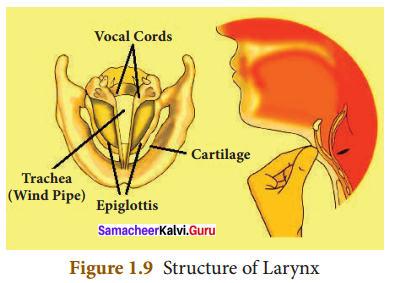
X. Solve the following cross word with the help of the given clues:
Clues Across:
2. The bouncing back of sound wave when it strikes a hard surface.
4. Form of matter of fixed shape other than liquid or gas.
6. Maximum distance moved by a vibrating body form its position of rest.
8.Waves which need a material medium for its propagation.
10. A kind of raepid to and fro motion of an object.
Down:
1. A unit used to measure the loudness or intensity of sound.
3. Sound wave whose frequency is too high to be heard by humans.
5. Sound wave whose frequency is too low to be heard by humans.
7. A reflection of sound.
9. The branch of science deals with the study of seismic waves.
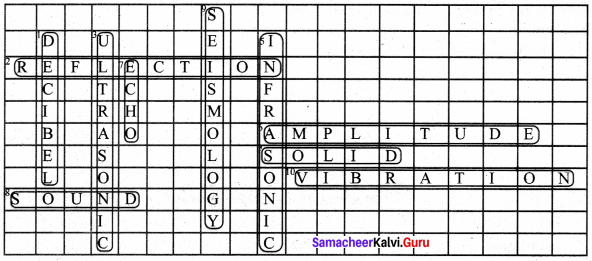
XI. Problems for practice:
Question 1.
A sound has a frequency of 60 Hz and a wavelength of 20 m. What is the speed of the sound?
Solution:
Given: Frequency n = 60 Hz
Wavelength λ = 20 m
To find: Speed V = ?
Formula: V = n λ
V = 20 x 60
V = 120 ms-1
Samacheer Kalvi 8th Science Sound Intext Activities
Activity – 1
Take the tray of an empty match box and stretch a rubber band around it, along its length. Then, pluck the stretched rubber band with your index finger. What do you observe? Do you hear any sound?
Answer:
Observation:
- On plucking the rubber band, it starts vibrating.
- We can hear a feeble humming sound as long as the rubber band is vibrating.
- The humming sound stops as soon as the rubber band stops vibrating.
Conclusion:
This confirms that sound is produced by vibrating bodies.
Activity – 2
Take a metal shallow pan. Hang it at a convenient place in such a way that it does not touch anything. Now, strike it with a stick. Touch the pan gently with your index finger. Do you feel the vibrations? Again, strike the pan with the stick and hold it tightly with your hands, immediately after striking. Do you still hear the sound?
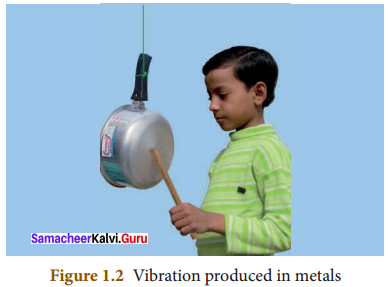
Answer:
Case 1:
- Now, strike it with a stick.
- Touch the pan gently with your index finger. Do you feel the vibrations?
Observation:
we can the feel the vibration for sometime.
Case 2:
- Strike the pan with the stick and hold tightly with your hands, immediately after striking.
- Do you still hear the sound?
Observation:
we cannot hear the sound.
Conclusion:
This activity shows the vibrating pan produces sound.
Activity – 3
Question 1.
Take a metal dish, pour some water in it. Strike it at its edge with a spoon. Do you hear any sound?
Answer:
We see that a vibrating object produces sound.

Question 2.
Again strike the dish and touch it. Can you feel the dish vibrating?
Answer:
I can feel the dish vibrating.
Question 3.
Strike the dish again. Look at the surface of water. Do you see any movement on the water surface?
Answer:
I can see the waves on the surface of water.
Question 4.
Now, hold the dish. What change do you observe on the surface of water?
Answer:
I cannot see the waves on the surface of water.
Activity – 4
Question 1.
Take two stones and strike them together and listen to the sound produced by them. Now take the stones underwater and strike them. You will find that the sound produced by the stones underwater is feeble and not very clear.
Answer:
Observation:
We observe that the sound produced by the stones underwater is feeble and not very clear.
Conclusion:
This activity shows that the speed of sound depends on the properties of the medium through which it travels.